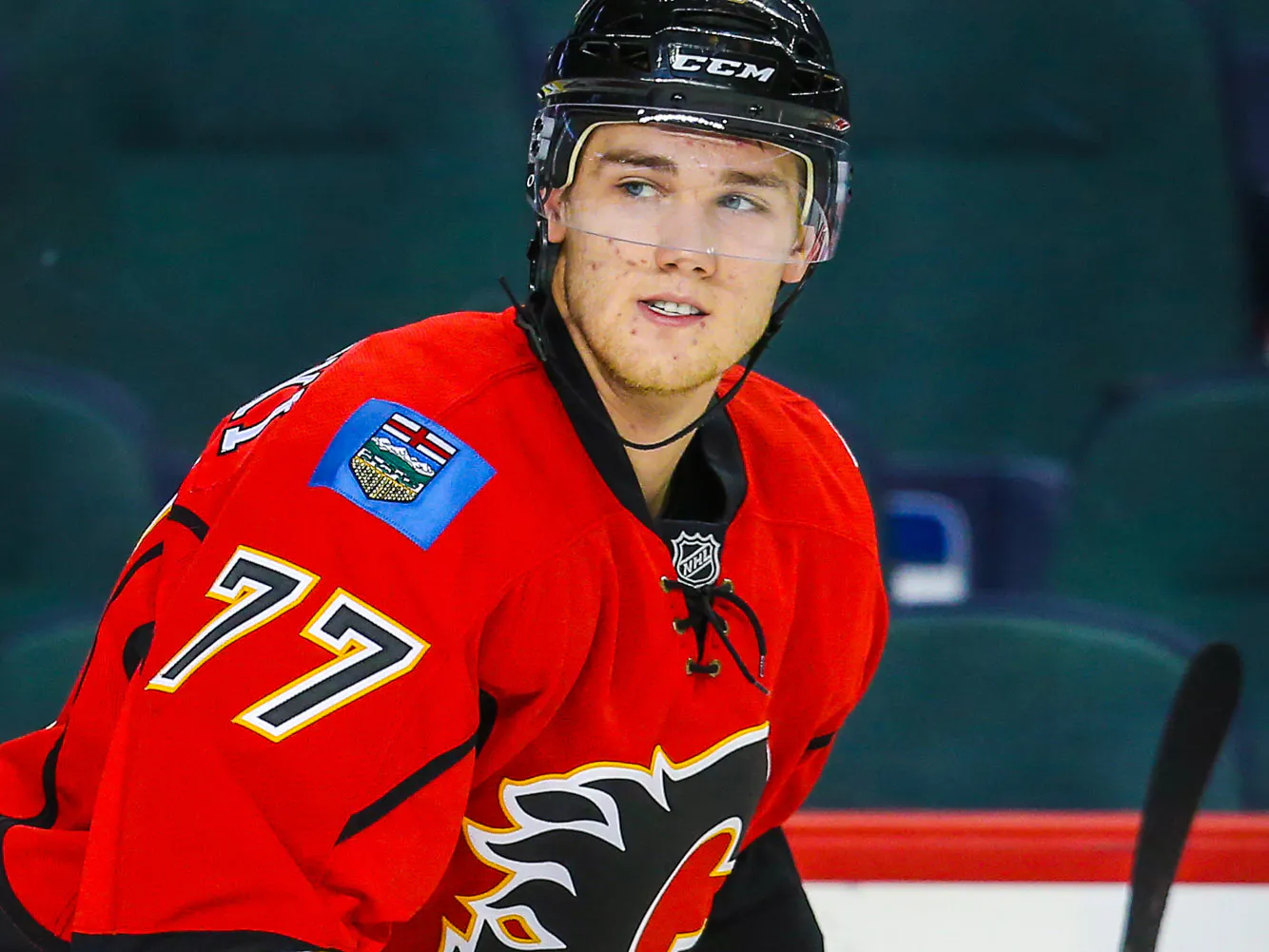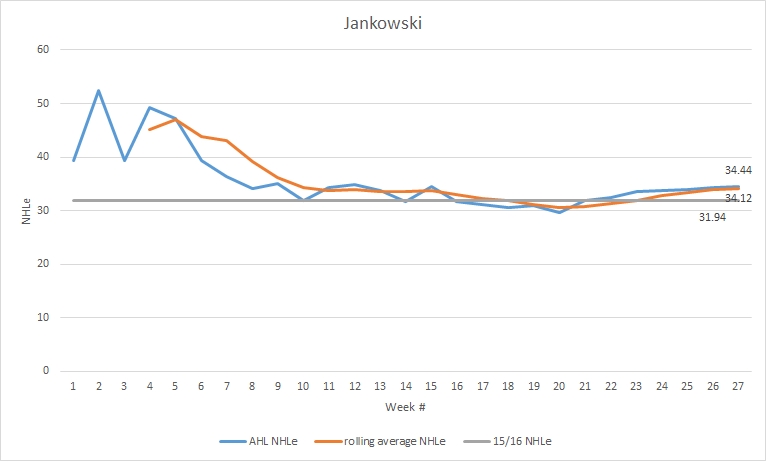Prospect wrap-up: Mark Jankowski

Turning promise into production has been goal #1 for Mark Jankowski, first round pick of the 2012 draft. Ever since Jay Feaster made his infamous declaration, the centre has been a lightning rod for controversy.
It’s been a long time coming. After some mixed reviews in college, Janko came flying out of the gate in the AHL and is oh-so-close to the NHL. Is the 10-year plan finally paying off?
Brief history
Jankowski, the highest player ever drafted out of a Canadian high school, went to Providence College for four years of hockey. After so-so freshman and sophomore years, he began gaining notoriety in his junior year after Providence went on a Cinderella run and upset heavy favourite Boston University to win the NCAA title. Janko won a nod for the all-tournament team for his effort in the Frozen Four.
His senior year received more hype. He won an all-conference team nod and was also named to the second NCAA all-American team. He signed with the Flames after a shocking loss in the first round of the tournament and put up an exciting AHL ATO campaign, scoring six points in eight games.
2016-17 performance
| GP-G-A-P | Primary Points | 5v5 P1 | NHLe |
| 64-27-29-56 | 45 | 27 | 34.44 |
All around, pretty good. I wouldn’t be too concerned about that low 5v5 primary points tally. Janko was a key element of Stockton’s powerplay (which was 21st in the league. Scary to think what it would be without him) and found a lot of points shorthanded.
He also led AHL rookies in goals, although his shooting percentage was a bit high for his career average, 17.31%. Perhaps he was facing easier goalies in the AHL than in college (of qualified goalies, the average SV% was .909), but he certainly does have a sharpshooting edge to him. His average, career wise, is 14.62%, so adjusting for that is five fewer goals, not that significant. If he makes the jump, expect that SH% to go down even more.

A running theme throughout Stockton Heat player wrap-ups is the slight dip that correlated to a terrible losing streak when 2017 began.
Janko was the beam of light which remained steady. Although his points total did slow down, he was steadier than many of his teammates. When the entire team got back into gear, Jankowski was scoring at a point-per-game pace towards the playoffs.
I guess the one concern would be the fact that his NHLe did not grow substantially from college to the AHL. The idea that he would be freed from defensive hockey appears to be true in his scoring numbers; however, he seems unable to break past the reality of what his NHLe suggests. A 30+ NHLe is good for a prospect in their draft year. For a player five years removed, not so much.
Cohorts and comparables
Any which way you cut it, Jankowski’s AHL season was great.
But the question becomes a matter of how well that will translate to the NHL. There’s quite a handful of players who have scored similarly at that age and done nothing afterwards. It’s not that uncommon to be great in the AHL five years removed from your draft year. Between 2005-06 and 2014-15, there have been a nice 69 AHLers between the ages of 21.5 and 22.5 (relative to Sept. 15. Janko is 22.005, by this measure) who have scored at a per game rate within 10% of what Jankowski scored this season (so, between 0.8 and 0.96). Here’s the full list of comparable players.
The results are not promising. Of the 69, only 26 went on to play more than 200 games (benchmark for what can be considered an established NHLer), or 38%. Of those successes, they scored at about a 0.42 PPG rate, which is around third-liner status. So if he defies the historical odds in making it, he will likely fall into the lower spectrum of NHL point production. Based on six of the 26 successes who went on to score higher than 0.5 PPG at the NHL, hitting the league and going above that measure has a whopping low 8% chance.
Historically, the chances of him breaking out into the superstar Jay Feaster imagined are very low. The data lines up nicely with his NHLe performance, suggesting that his ceiling is likely that of a third line centre.
Final thoughts
The narrative attached to Janko was that he would prove the doubters wrong and be even better the next year. He’s going to hope that rings true more than ever.
Part of the major risk surrounding him was the very small window in which he has to establish himself as an effective NHLer. When his contract runs out, he’ll be on the verge of 24, when most NHLers start to enter their prime. If he isn’t an NHLer by then, it’s likely never going to happen.
And come next training camp, that window will be extremely tiny and on the verge of closing. What applies to Hunter Shinkaruk applies to Jankowski. There might be one open spot on the roster and many people vying for it. There’s even less room at the centre position, where the Flames have three better options (two of them younger) in Sean Monahan, Sam Bennett, and Mikael Backlund. If those comparables hold true, he’s not going to replace any of those guys next year.
The only centre he can replace is Matt Stajan, but that’s not as easy a task as it seems. Stajan is still trusted and relied upon by the coaches, and his underlying numbers suggest that he’s not an active detriment to the team. Unless Stajan gets claimed by Las Vegas, there’s four established centres. This gets even more complicated when you remember that Curtis Lazar exists and is a natural centre. If Stajan goes, the competition is between Jankowski and Lazar, and gut feeling says Lazar gets that spot. Again, tiny window.
It’s all going to be a mess that won’t be resolved until September. If a bottom six spot is available, there’s going to be a fierce battle for it. Jankowski is the front runner right now just off of name value and his 2016-17 season, but he also has the most to lose. If he’s cut from the team, it’s probably over.
Previously
Hunter Shinkaruk, Rasmus Andersson, Kenney Morrison, Tyler Wotherspoon, Oliver Kylington, Stepan Falkovsky, Keegan Kanzig/Mason McDonald, Ryan Culkin/Brett Pollock, Mitchell Mattson, Adam Fox, Brandon Hickey, Riley Bruce/Nick Schneider, Tyler Parsons, Eetu Tuulola, Matt Phillips, Dillon Dube, Adam Ollas Mattsson, Linus Lindstrom, Pavel Karnaukhov/Rushan Rafikov, Tim Harrison
Recent articles from christian tiberi





